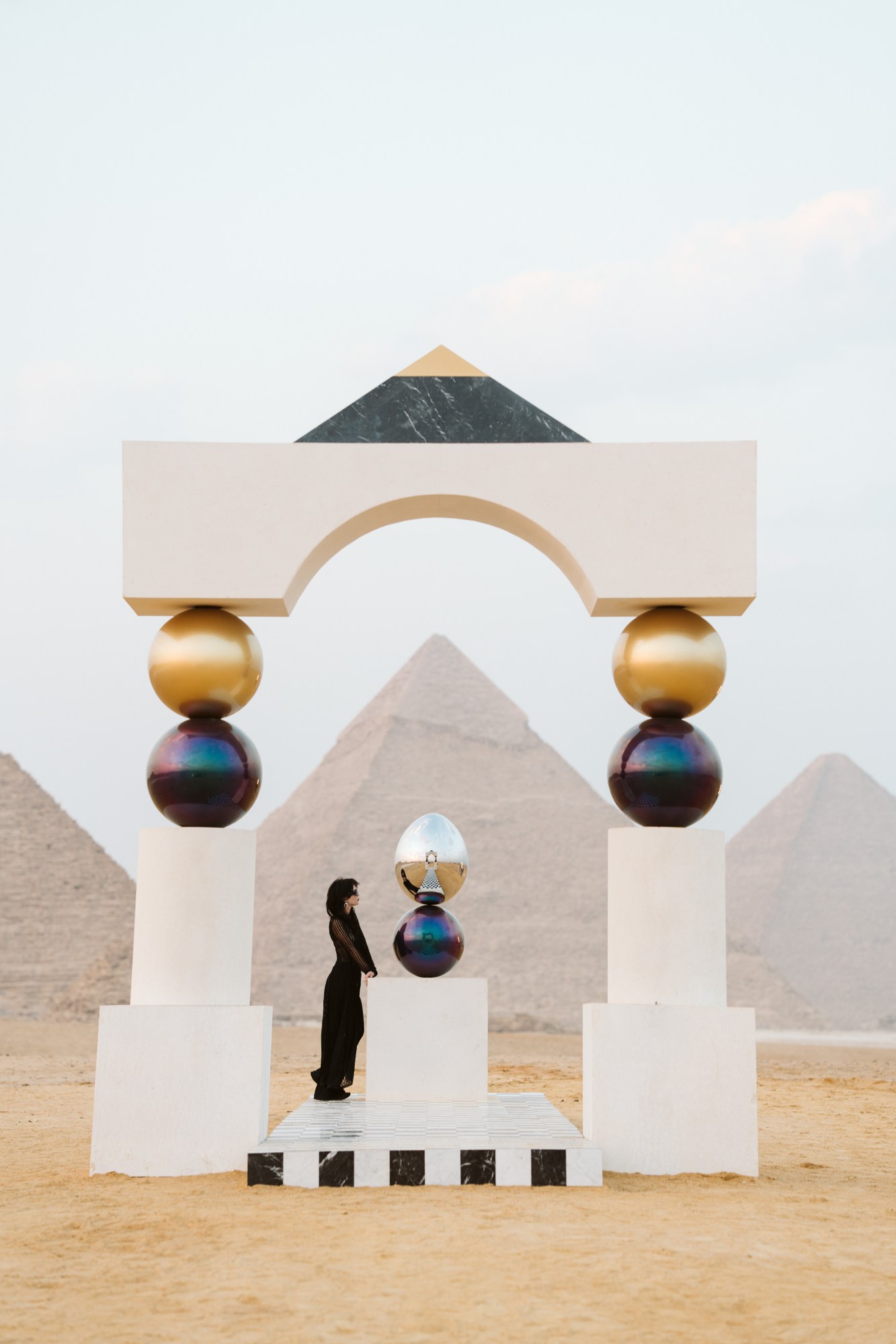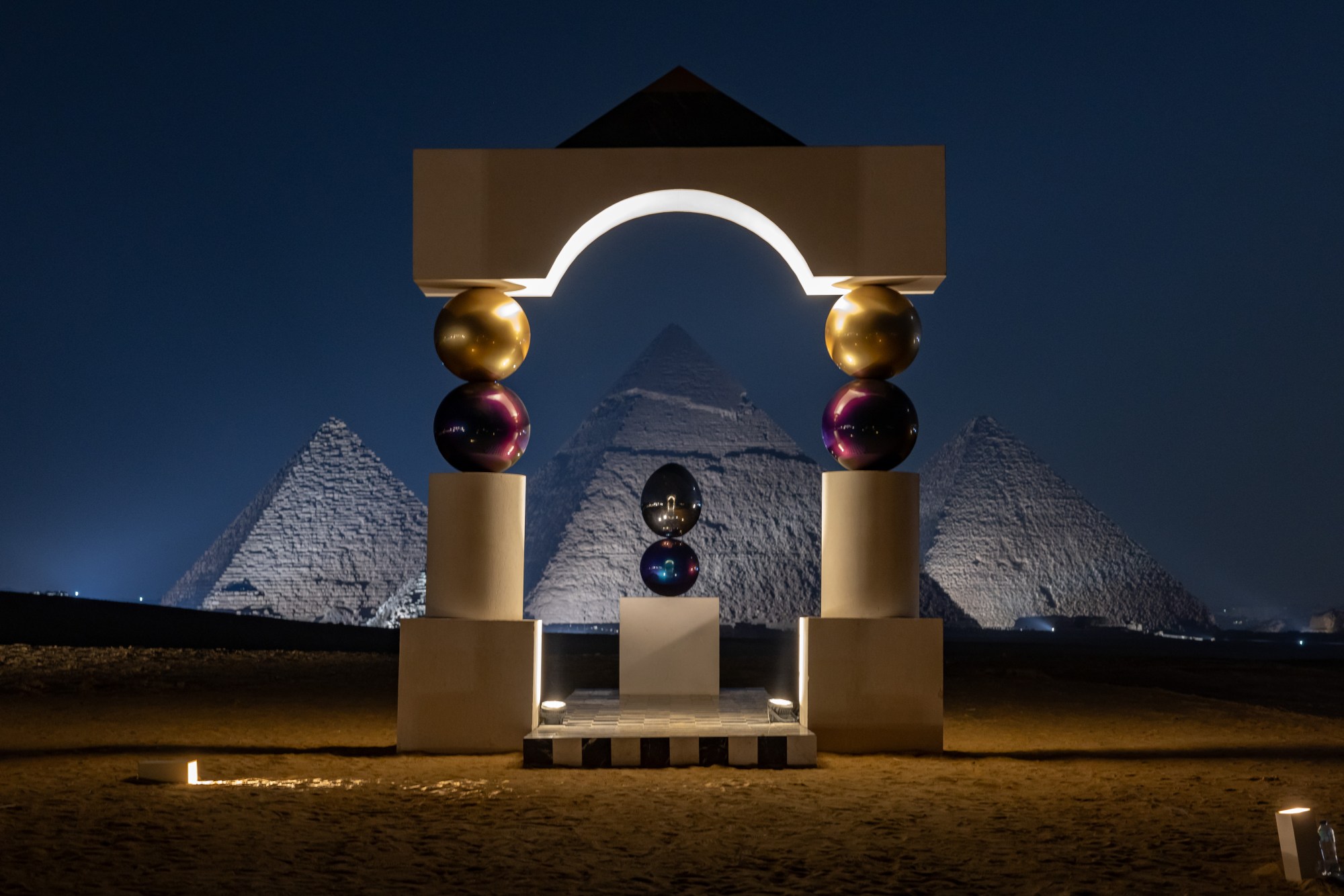The pyramids of Giza, surrounded by expansive deserts, centuries-old valleys and majestic architecture, stand as an enduring reminder of human ingenuity. When Pilar Zeta — an Argentinian multimedia artist, graphic designer and creative director based in Mexico City — first visited the pyramids a decade ago, this ignited a lasting fascination with Ancient Egypt. “As I laid down in the sarcophagus of the King’s Chamber at the Great Pyramid, I felt a profound connection with a higher source,” she recalls. “This experience ultimately led me to create my work in proximity to them. This is a testament to how powerful I believe the pyramids are.”
The geometric precision of ancient Egyptian architecture began to seep into Pilar’s own creations. In her earlier works, such as Field of Visions, Pilar crafted a 3D desert landscape adorned with surrealistic structures, golden spheres that roll like cosmic dice and distant pyramids casting an alluring spell in the background. The same can be said for the sun-kissed, rocky landscapes found in The Second Self, a film she directed for Bimba Y Lola, the material-rich Interrealm Portal and a sculptural chess set both reminiscent of ancient temples and tombs. Pilar has also lent her artistic vision to artworks for musicians like Coldplay; she was the creative director for Lil Nas X’s debut album, MONTERO, and Camila Cabello’s “Don’t Go Yet” music video.

So when the organisers behind the third edition of Forever is Now — an exhibition of 14 international artists set against the backdrop of the Pyramids of Giza — reached out to Pilar, the invitation felt like a poignant homecoming. Tasked to engage with one of the world’s most iconic landmarks, her new sculpture, entitled “Mirror Gate”, replete with patterns and hues inspired by Postmodernism, pays homage to this not-forgotten era. Constructed from limestone, the same material used to build the pyramids, alongside stainless steel, car paint, marble and fibreglass, the sculpture features a grand archway that beckons viewers to pass through. A mirrored egg is at the centre, resting atop a plinth in perfect symmetry with the pyramids. “I use symbols as a means to connect with our subconscious,” she explains. “The egg symbolises birth and creation, while portals represent the entry into new realities and checkerboard floors symbolise duality.”
With this piece, Pilar aims to “connect past, present and future” in a static space, using the egg as a transportation device. Viewers are encouraged to gaze into its surface and pause momentarily, capturing glimpses of themselves and the distorted landscape in the reflection. “The idea is to connect with a potential in the future while looking at ourselves,” Pilar explains. The concept is derived from Egyptian mythology, where the god Thoth is often depicted with the head of an ibis (a large wading bird) and holding a cosmic egg, the key to all of life’s creation.

The sculpture harmoniously merges with the immense presence of the pyramids, forging a deep connection with ancient times. What sets it apart, though, is the use of colour. Pilar skillfully combines geometric shapes with a palette of vivid hues, contrasting the warm, earthy tones of limestone with stark monochromes and glassy materials. An iridescent blue — “the colour of transmutation” — is applied to the spheres holding the trunks together, nodding to the sacred beetle, a symbol of the eternal cycle of life. As the light changes throughout the day, the sculpture’s colours evolve and the view of the pyramids shift entirely. “It’s a wonderful experience as the art initiates a dynamic conversation with the site,” she says.
“Mirror Gate” serves as a portal to a bygone civilisation and a means of connecting to the energy of the pyramids. “I aim for people to use the art as a form of ritualistic experience, connecting with the present and simultaneously engaging with one of the world’s most significant marvels,” she finishes. “This symbolic presence can have a substantial impact, and I believe it can help us move into a more elevated future.”
Running until 18 November at the pyramids of Giza, ‘Forever Is Now’ is organised and curated by CulturVator, Art D’Egypte, under guidance of the ministries of tourism and antiquities, foreign affairs and culture, and the Egyptian National Commission for UNESCO.

Credits
Images courtesy Art D’Egypte/Culturvator
